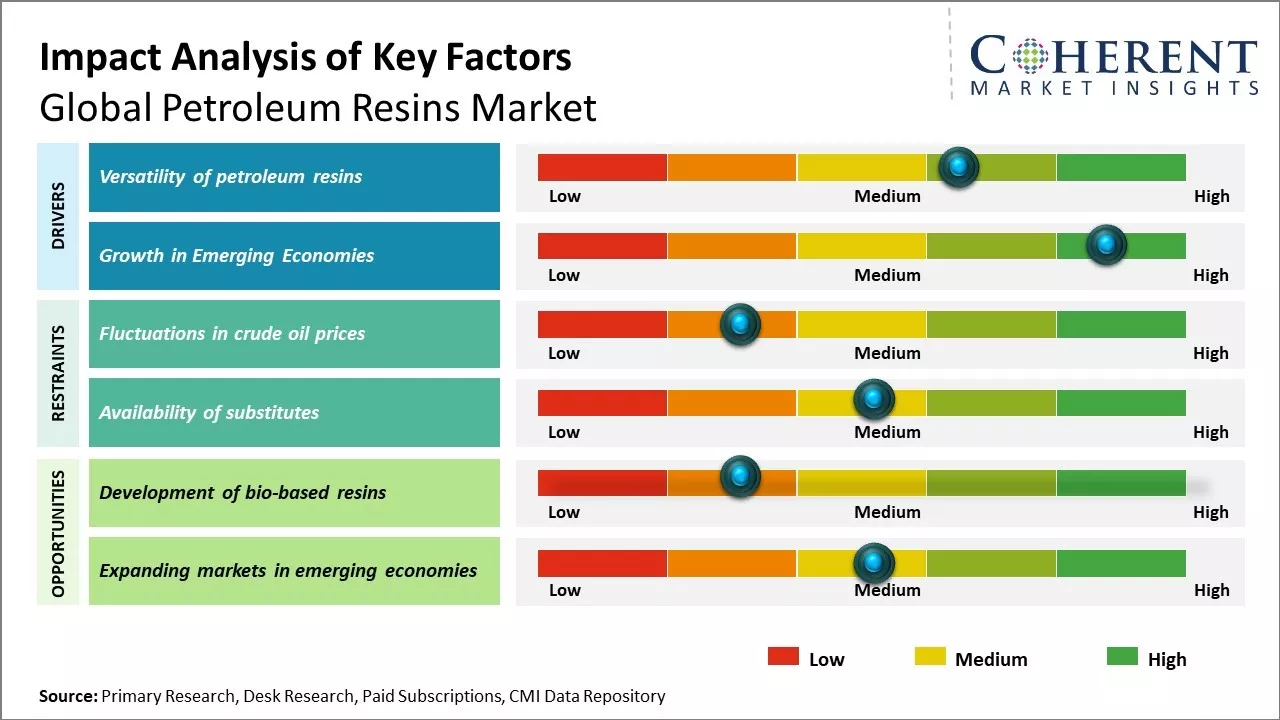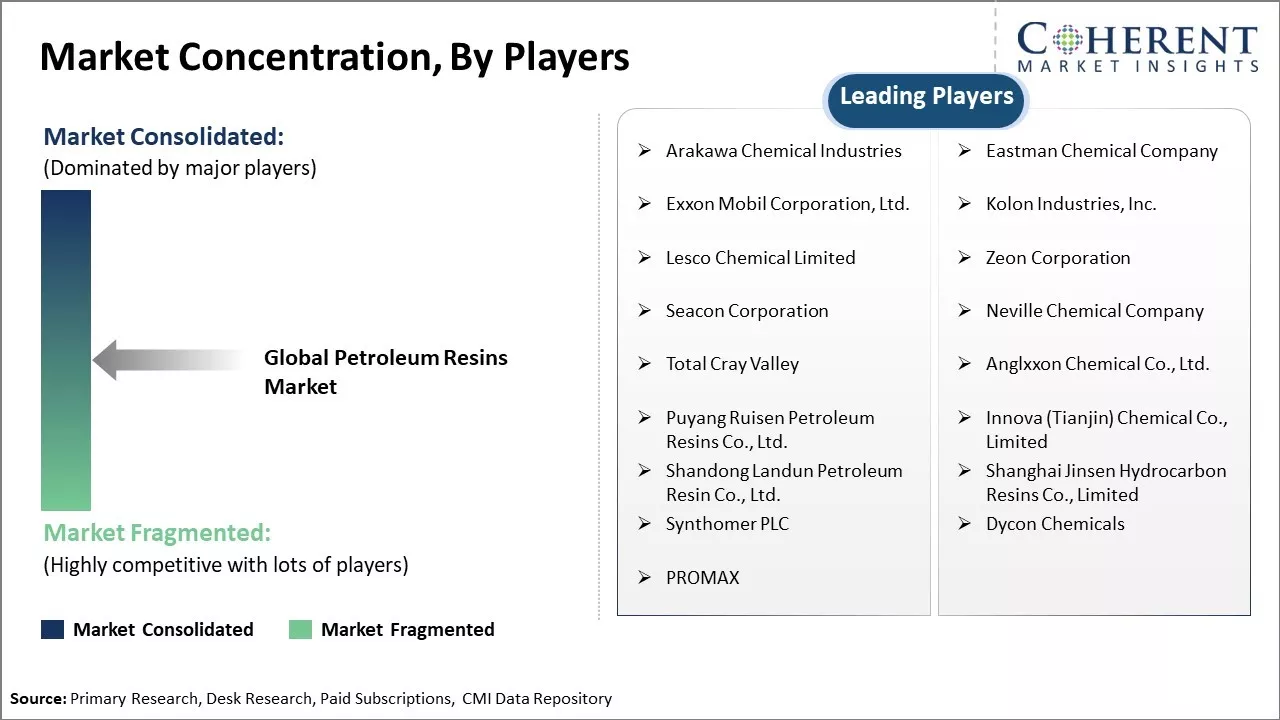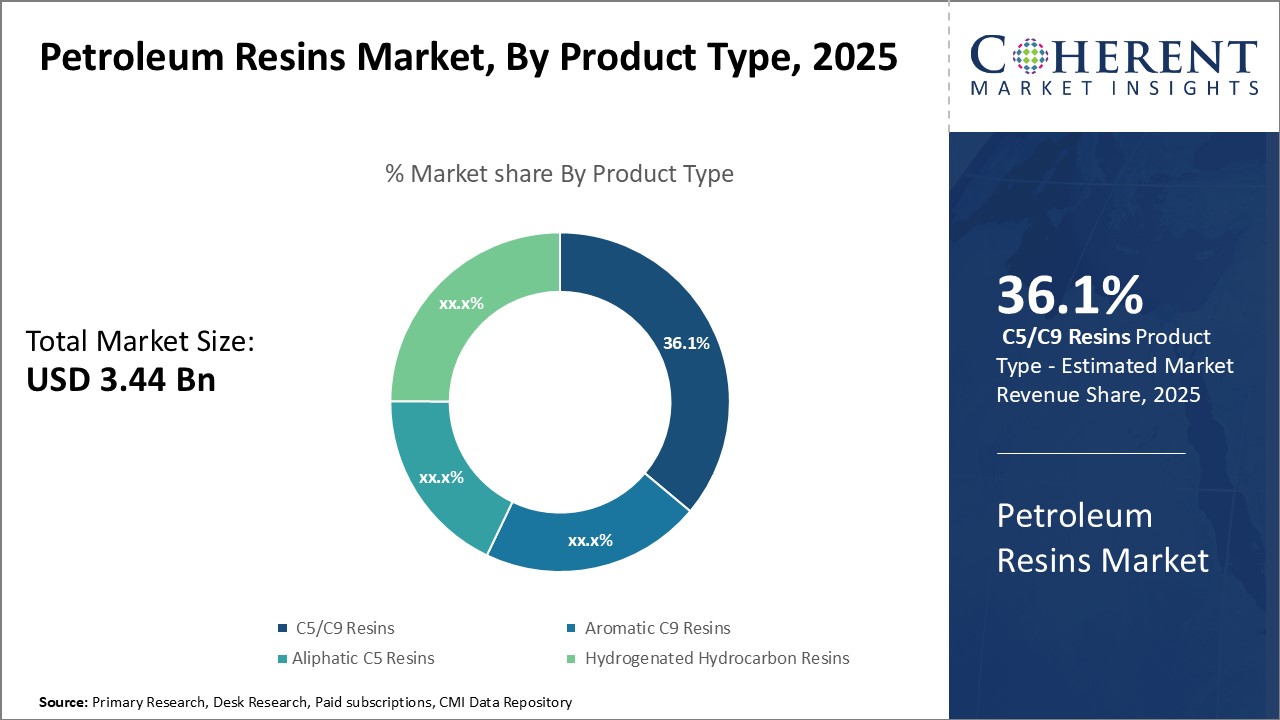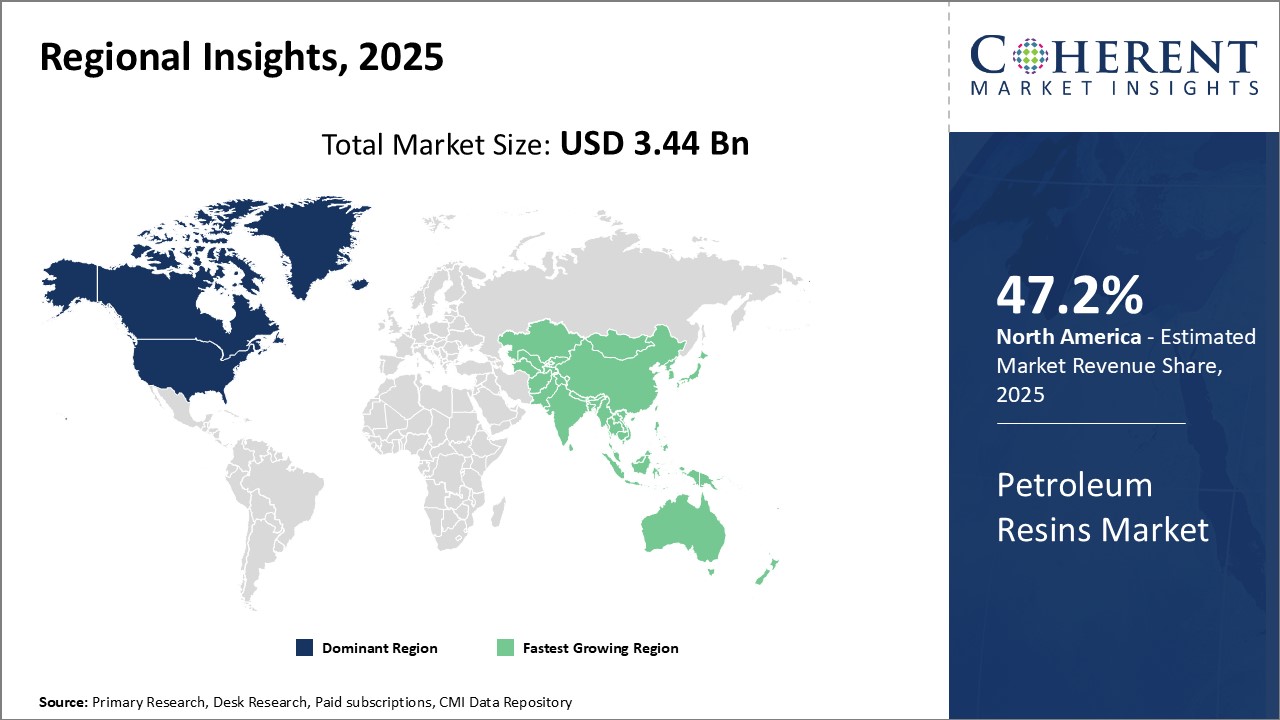The Petroleum Resins Market is estimated to be valued at USD 3.44 Bn in 2025 and is expected to reach USD 5.75 Bn by 2032, exhibiting a compound annual growth rate (CAGR) of 7.6% from 2025 to 2032.

Discover market dynamics shaping the industry: Download Free Sample
The market is expected to witness positive growth over the forecast period. This can be attributed to growing demand from various end-use industries such as paints & coatings, rubber products, adhesives & sealants, and printing inks. Petroleum resins are primarily used to produce coatings, varnishes & paints which have high gloss, toughness and resilience. Rapid growth of the global paints & coatings industry due to infrastructure development, urbanization and growing automotive industry is boosting the demand for petroleum resins. Increasing usage of petroleum resins in road marking application and printing ink industry is one of the most significant factors driving the market revenue growth over the forecast period.
Versatility of petroleum resins
Petroleum resins are gaining prominence in the global market owing to their versatile properties and wide range of applications. With excellent adhesion, flexibility, UV resistance and weatherability, petroleum resins can efficiently replace other materials across several end-use industries. Their ability to blend with other polymers makes them suitable for a variety of applications which conventional polymers may not be able to accomplish. Due to their versatile characteristics, petroleum resins are being increasingly used in coatings, inks, adhesives, sealants and other applications. In coatings, they provide good surface hardness, scratch resistance and gloss retention in both interior and exterior paints. They are also being widely used in solvent-borne and waterborne coating systems replacing other resins. In printing inks, petroleum resins improve the pigment bonding, gloss, color strength and flexibility of the dried ink films. This has augmented their usage in publication, packaging and digital inks. Their excellent adhesion properties make them apt for pressure-sensitive and hot-melt adhesives where high tack and heat resistance are important. They are also replacing other synthetic tackifiers at a good pace in sealants and carpet backing.

Get actionable strategies to beat competition: Download Free Sample
Growth in Emerging Economies
Strong economic expansion in developing nations has created tremendous opportunities for industries serving growing middle classes. The construction, automotive and consumer goods sectors in these emerging markets require large volumes of adhesives, paints, packaging and other products that utilize petroleum resins. Global producers have invested heavily in expanding petroleum resins production capacity across Asia Pacific and Latin America to better serve these high-potential regional markets. China in particular presents a massive driver of demand, with its immense infrastructure ambitions and upwardly mobile population of over a billion consumers. With their cost-competitive manufacturing bases and improving standards of living, emerging economies will likely continue powering petroleum resins consumption for years to come as industrialization and development accelerate in these regions.
Key Takeaways of Analyst:
The petroleum resins market growth continues to be driven by growing demand from major end-use industries such as paints & coatings, rubber, and adhesives & sealants. The paints & coatings industry in particular is projected to remain a dominant consumer of petroleum resins over the forecast period. Asia Pacific holds the largest share of the market currently and is expected to maintain its lead, supported by increasing coating needs in the construction and automotive industries of China and India. Growing infrastructure investment and rising vehicle ownership in these populous nations will propel the region's petroleum resins consumption.
Stringent environmental regulations could pose a challenge as some petroleum resin grades do not meet the low-VOC standards prescribed in developed markets. Resin producers may need to innovate new product lines to comply with these norms. Moreover, availability of bio-based alternative resins may hamper revenue growth to an extent. However, their limited production capacities and higher prices compared to conventional resins continue to favor overall demand for petroleum-derived varieties.
Opportunities exist in the form of new product development, particularly in the adhesives field which is witnessing rapid innovation. As manufacturers seek alternatives to solvent-based adhesives, petroleum resins that provide comparable performance along with lower emissions.
Challenges: Fluctuations in crude oil prices
The fluctuations in global crude oil prices have significantly restrained the growth of the global petroleum resins market in recent years. Petroleum resins are primarily derived from petroleum-based feedstock such as C5 and aromatic hydrocarbons which are by-products obtained during the refining of crude oil. Hence, the prices of crude oil have a direct impact on the production costs and operating margins of petroleum resins manufacturers. Over the past few years, benchmark international crude oil prices have witnessed high volatility driven by various geopolitical and macroeconomic factors.
Opportunities: Development of bio-based resins
The development of bio-based resins presents a major opportunity for growth in the global petroleum resins market. Petroleum resins are traditionally derived from petroleum-based feedstocks. However, increasing concerns about sustainability and reliance on non-renewable resources are driving demand for more eco-friendly bio-based alternatives. Transitioning to bio-based resins allows product manufacturers to reduce their carbon footprint and meet stringent environmental standards. As governments and corporations adopt net-zero emissions targets, bio-based resins offering are gaining immense traction.

Discover high revenue pocket segments and roadmap to it: Download Free Sample
Insights By Product Type : Versatility Applications of C5/C9 Resins drive the segment growthC5/C9 resins segment is estimated to hold 36.1% share in the petroleum resins market in 2025, by product type due to their versatile application properties. These resins are a blend of C5 and C9 resins, combining the desirable characteristics of each. C5/C9 resins perform well in hot melt and solvent-based adhesive applications due to their balanced molecular structure. They have excellent compatibility with various substrates like rubber, thermoplastics and thermosets. This compatibility enables C5/C9 resins to be used in pressure sensitive adhesives, construction adhesives, bookbinding adhesives and tire adhesives among others. Their versatility also extends to coatings and printing ink applications. C5/C9 resins improve properties like flexibility, resistance to heat and weathering when added to coatings. They are used in architectural paints, traffic paints and general industrial coatings. In printing inks, C5/C9 resins enhance adhesion, gloss and tack. Their performance in publication gravure, packaging and news printing inks has propelled their market share. C5/C9 resins also find favor in applications like rubber compounding, caulking and gasketing. Their solidity at room temperature coupled with flexibility at higher temperatures makes them suitable for modifying rubber. This improves rubber properties such as tensile strength and compression set resistance. The ability of C5/C9 resins to serve diverse purposes across various end-use industries through their balanced properties has cemented their top position in the petroleum resins market. Further innovations to enhance their existing attributes is likely to maintain their market dominance going forward.
Insights by application: Demand from Adhesive Applications
Within application, adhesive and sealants segment is estimated to hold 37.2% share to the petroleum resins market in 2025. This is primarily attributed to the growing demand for petroleum resins from the adhesive industry. Petroleum resins are widely used in hot melt, pressure sensitive and structural adhesives owing to properties like tackiness and adhesion. They help modify the rheology and open time of adhesives. Hot melt adhesives containing petroleum resins are used in packaging, tapes, non-woven hygienic products and bookbinding. Demand is also increasing from pressure sensitive adhesives used in medical dressings, tapes and labels. Petroleum resins provide shear and peel strength to these adhesives along with resistance to heat, moisture and aging. In construction adhesives for flooring, roofing, and other applications, petroleum resins improve the strength and reliability of bonds formed on different substrates. They enhance the weatherability of sealants and caulking compounds used in construction. The broad ranging use of petroleum resins in the booming adhesive and sealants market across industries like packaging, medical, construction etc. has made it the major application segment. Infrastructure development and growing packaging and labeling needs will continue spurring demand from this segment over the forecast period.
Insights by end use industry : Use in High-Performance Automotive Components, Automotive leads in End-use Industry
In terms of end-use industry, automotive segment is estimated to hold 36.2% share of the global petroleum resins market in 2025. This can be attributed to the extensive use of petroleum resins in high-performance automotive components and parts. Petroleum resins enhance the thermal and mechanical properties of under-the-hood components in vehicles subjected to heavy loads and high operating temperatures. They are used in engine mounts, suspension bushings and other mounts to impart fatigue resistance. As adhesives in vehicle manufacturing, petroleum resin formulations provide heat resistance in bonding vehicle bodies and parts together. They also find increasing application in structural foam molding of automobile seats, door panels, dashboards and others to reduce weight. Tire manufacturing consumes petroleum resins as they modify the properties of rubber, imparting strength and resistance to wear and abrasion. Petroleum resins also function as process aids during tire cure. With the automotive industry pushing for enhanced efficiency, comfort and safety in vehicles, the demand for engineered systems and lightweight components continues growing. This drives consistent consumption of high-performance petroleum resins from the automotive segment above other end-use industries.

Need a Different Region or Segment? Download Free Sample
North America has established itself as the dominant region in the global petroleum resins market. With the presence of major resin manufacturers and a well-developed end-use industries, the North American market is estimated to account for around 47.2% of the global demand for petroleum resins market in 2025. The U.S. is the world's largest consumer of petroleum resins due to high consumption from industries such as paints & coatings, adhesives & sealants, printing inks, and rubber. The high usage of resins from manufacturers to produce various goods that are then exported globally has made North America an important manufacturing and trading hub for petroleum resins. Some key factors that have contributed to the large market size are the innovation in resin formulations by manufacturers to match diverse performance requirements across industries and strong production capacities built over the years by leading resin producers. Additionally, consolidation activities among competitors have enhanced their distribution networks across the region.
On the other hand, Asia Pacific has shown promising signs of emerging as the fastest expanding market for petroleum resins. With increasing industrial and infrastructure development, nations like China, India, and Southeast Asia are witnessing surge in the consumption of resins by end-use sectors like paints & coatings and adhesive & sealants. Countries like China and India have substantial export-oriented manufacturing industries, fostering demand for petroleum resins. Rising disposable income levels, population growth and foreign investments have augmented the production and output of various end products in Asia requiring resin additives. Stimulus packages by governments aimed at infrastructure projects have also benefitted the resins market. Additionally, many global resin manufacturers have been establishing new production plants or expanding existing ones in the region to leverage low-cost manufacturing and cater to the growing needs of Asia Pacific. With such trends prevailing, the Asia Pacific market is likely to record exponential gains in the coming years.
Petroleum Resins Market Report Coverage
| Report Coverage | Details | ||
|---|---|---|---|
| Base Year: | 2024 | Market Size in 2025: | USD 3.44 Bn |
| Historical Data for: | 2020 To 2024 | Forecast Period: | 2025 To 2032 |
| Forecast Period 2025 to 2032 CAGR: | 7.6% | 2032 Value Projection: | USD 5.75 Bn |
| Geographies covered: |
|
||
| Segments covered: |
|
||
| Companies covered: |
Arakawa Chemical Industries, Eastman Chemical Company, Exxon Mobil Corporation, Ltd., Kolon Industries, Inc., Lesco Chemical Limited, Zeon Corporation, Seacon Corporation, Neville Chemical Company, Total Cray Valley, Anglxxon Chemical Co., Ltd., Puyang Ruisen Petroleum Resins Co., Ltd., Innova (Tianjin) Chemical Co., Limited, Shandong Landun Petroleum Resin Co., Ltd., Shanghai Jinsen Hydrocarbon Resins Co., Limited, Synthomer PLC, Dycon Chemicals, and PROMAX |
||
| Growth Drivers: |
|
||
| Restraints & Challenges: |
|
||
Uncover macros and micros vetted on 75+ parameters: Get instant access to report
*Definition: The petroleum resins market involves the production and sale of aliphatic and aromatic hydrocarbon resins derived from petroleum distillates through polymerization reactions. These resins are primarily used as tackifiers in hot melts, pressure-sensitive adhesives, road marking, and other applications due to their ability to impart tackiness and bonding strength. The global petroleum resins market has witnessed steady growth due to increasing demand from the adhesives and sealants industry for applications in constructions, packaging, and other.
Share
Share
About Author
Yash Doshi is a Senior Management Consultant. He has 12+ years of experience in conducting research and handling consulting projects across verticals in APAC, EMEA, and the Americas.
He brings strong acumen in helping chemical companies navigate complex challenges and identify growth opportunities. He has deep expertise across the chemicals value chain, including commodity, specialty and fine chemicals, plastics and polymers, and petrochemicals. Yash is a sought-after speaker at industry conferences and contributes to various publications on topics related commodity, specialty and fine chemicals, plastics and polymers, and petrochemicals.
Missing comfort of reading report in your local language? Find your preferred language :
Transform your Strategy with Exclusive Trending Reports :
Frequently Asked Questions
Joining thousands of companies around the world committed to making the Excellent Business Solutions.
View All Our Clients